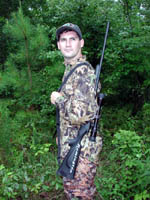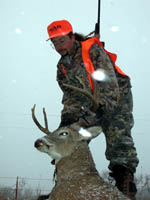
|
Features
|
|
|
|
Books
|
|
|
|
Fun & Games
|
|
|
|
Contact Us
|
|
|
John's Journal... Entry 221, Day 3
STEPS FOR FINDING DOWNED WHITETAILS
Carefully Analyze What Your Deer Has Done
 Editor's
Note: Often your hunt really begins once you've shot or arrowed a deer.
Merely inflicting a mortal wound on a whitetail doesn't finish the hunt.
Only after you've recovered the animal can you call your hunt a success.
Let's look at the steps that will help you locate your downed whitetail.
Editor's
Note: Often your hunt really begins once you've shot or arrowed a deer.
Merely inflicting a mortal wound on a whitetail doesn't finish the hunt.
Only after you've recovered the animal can you call your hunt a success.
Let's look at the steps that will help you locate your downed whitetail.
When you leave your stand, go directly to the spot where you think
the shot has hit the deer. Look for hair, blood, bone and stomach
content. The deer's shortest and usually darkest hairs cover the top
of its back. Although a deer's side will have longer, lighter-colored
hair, his stomach will have the lightest-colored and longest hair.
Deer have short white hairs under their chins, inside their ears and
on their tails. The hair you discover often will tell you where the
shot has hit the deer. Too, if you locate blood that has air bubbles
in it, you've more than likely made a lung shot. If you find stomach
content, you've probably hit the deer low and may need to wait several
hours before you begin tracking the animal. Try to obtain all the
information you can from the place where you've hit the deer.
 A
good blood trail may make following the animal easy. With no blood
trail, you may have to rely on tracks and what you've already seen
and heard to locate your buck. However, even if you do see a blood
trail, study the tracks of the animal. Note the size and shape of
the track -- its width and its length. Identify any characteristics
that will help you distinguish this deer's track from another's. Once
you've studied the shot site carefully and obtained all the information
you can gather, begin to follow the trail.
A
good blood trail may make following the animal easy. With no blood
trail, you may have to rely on tracks and what you've already seen
and heard to locate your buck. However, even if you do see a blood
trail, study the tracks of the animal. Note the size and shape of
the track -- its width and its length. Identify any characteristics
that will help you distinguish this deer's track from another's. Once
you've studied the shot site carefully and obtained all the information
you can gather, begin to follow the trail.
By using flagging tape to mark the trail as you go, you can see the
deer's direction of travel. You also can find your way back to your
tree stand and the last place where you've located the deer's blood.
Flagging tape provides an invaluable tool for trailing a wounded animal.
TOMORROW: GO SLOW AND LOOK UP
Check back each day this week for more
about STEPS FOR FINDING DOWNED
WHITETAILS ...
Day 1 - Look and Listen
Day 2 - Wait and Get a Bearing
Day 3 - Carefully Analyze What Your Deer
Has Done
Day 4 - Go Slow and Look Up
Day 5 - Know What To Do and Employ a Keener
Nose